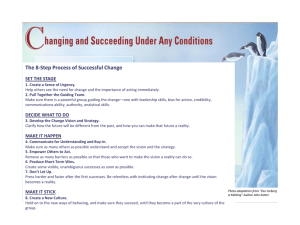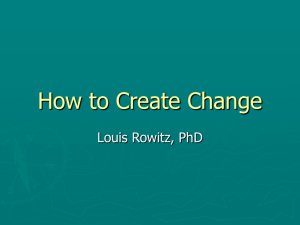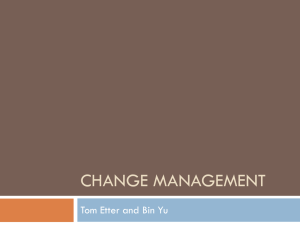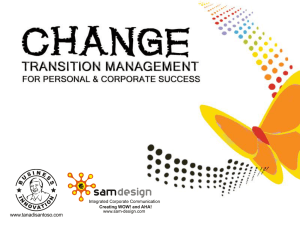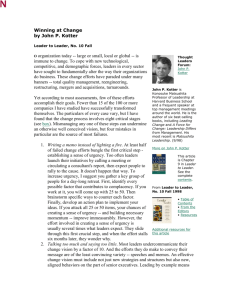Managing Change Presentation - Kyle Shulfer
advertisement
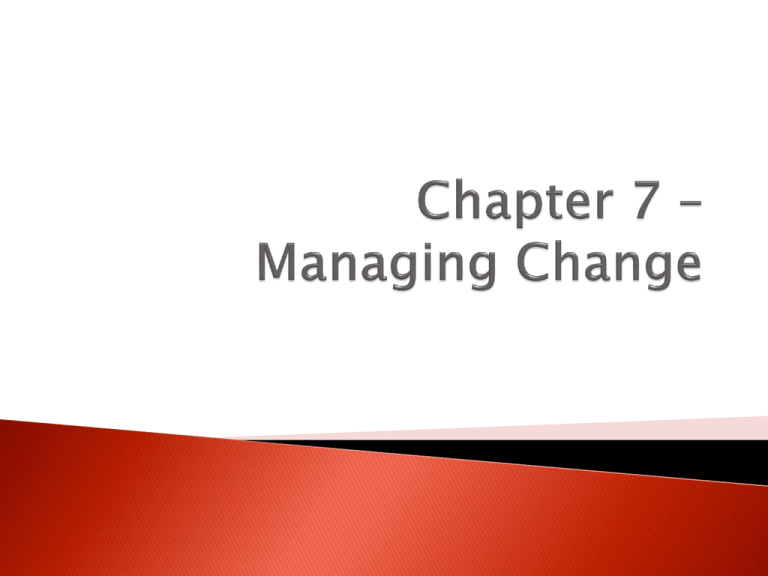
Although indispensable for long-term firm growth, organizational changes are usually met with resistance. By knowing how to design, approach and manage the changes your firm needs to implement, you can maximize the effectiveness of the change and minimize the resistance met during the change process. Organizational change is a structured approach in an organization for ensuring that changes are smoothly and successfully implemented to achieve lasting benefits. In the modern business environment, organizations face rapid change like never before. Globalization and the constant innovation of technology result in a constantly evolving business environment. Phenomena such as social media and mobile adaptability have revolutionized business and the effect of this is an ever increasing need for change, and therefore change management. The growth in technology also has a secondary effect of increasing the availability and therefore accountability of knowledge. Easily accessible information has resulted in unprecedented scrutiny from stockholders and the media With the business environment experiencing so much change, organizations must then learn to become comfortable with change as well. Therefore, the ability to manage and adapt to organizational change is an essential ability required in the workplace today. Due to the growth of technology, modern organizational change is largely motivated by exterior innovations rather than internal moves. When these developments occur, the organizations that adapt quickest create a competitive advantage for themselves, while the companies that refuse to change get left behind. This can result in drastic profit and/or market share losses. Organizational change directly affects all departments from the entry level employee to senior management. The entire company must learn how to handle changes to the organization. When determining which of the latest techniques or innovations to adopt, there are four major factors to be considered: ◦ ◦ ◦ ◦ Levels, goals, and strategies Measurement system Sequence of steps Implementation and organizational change ◦ ◦ ◦ ◦ Recognizing the changes in the broader business environment Developing the necessary adjustments for their company’s needs Training their employees on the appropriate changes Winning the support of the employees with the persuasiveness of the appropriate adjustments Regardless of the many types of organizational change, the critical aspect is a company’s ability to win the buy-in of their organization’s employees on the change. Effectively managing organizational change is a four-step process: As a multidisciplinary practice that has evolved as a result of scholarly research, organizational change management should begin with a systematic diagnosis of the current situation in order to determine both the need for change and the capability to change. The objectives, content, and process of change should all be specified as part of a Change Management plan. Change management processes should include creative marketing to enable communication between changing audiences, as well as deep social understanding about leadership’s styles and group dynamics. As a visible track on transformation projects, Organizational Change Management aligns groups’ expectations, communicates, integrates teams and manages people training. It makes use of performance metrics, such as financial results, operational efficiency, leadership commitment, communication effectiveness, and the perceived need for change to design appropriate strategies, in order to avoid change failures or resolve troubled change projects. Successful change management is more likely to occur if the following are included:[ Benefits management and realization to define measurable stakeholder aims, create a business case for their achievement (which should be continuously updated), and monitor assumptions, risks, dependencies, costs, return on investment, dis-benefits and cultural issues affecting the progress of the associated work Effective communication that informs various stakeholders of the reasons for the change (why?), the benefits of successful implementation (what is in it for us, and you) as well as the details of the change (when? where? who is involved? how much will it cost? etc.) Devise an effective education, training and/or skills upgrading scheme for the organization Counter resistance from the employees of companies and align them to overall strategic direction of the organization Provide personal counseling (if required) to alleviate any change-related fears Monitoring of the implementation and fine-tuning as required Step 1: Create Urgency For change to happen, it helps if the whole company really wants it. Develop a sense of urgency around the need for change. This may help you spark the initial motivation to get things moving. This isn't simply a matter of showing people poor sales statistics or talking about increased competition. Open an honest and convincing dialogue about what's happening in the marketplace and with your competition. If many people start talking about the change you propose, the urgency can build and feed on itself. What you can do: ◦ ◦ ◦ ◦ Identify potential threats, and develop scenarios showing what could happen in the future. Examine opportunities that should be, or could be, exploited. Start honest discussions, and give dynamic and convincing reasons to get people talking and thinking. Request support from customers, outside stakeholders and industry people to strengthen your argument. Note: Kotter suggests that for change to be successful, 75 percent of a company's management needs to "buy into" the change. In other words, you have to work really hard on Step 1, and spend significant time and energy building urgency, before moving onto the next steps. Don't panic and jump in too fast because you don't want to risk further short-term losses – if you act without proper preparation, you could be in for a very bumpy ride. Step 2: Form a Powerful Coalition Convince people that change is necessary. This often takes strong leadership and visible support from key people within your organization. Managing change isn't enough – you have to lead it. You can find effective change leaders throughout your organization – they don't necessarily follow the traditional company hierarchy. To lead change, you need to bring together a coalition, or team, of influential people whose power comes from a variety of sources, including job title, status, expertise, and political importance. Once formed, your "change coalition" needs to work as a team, continuing to build urgency and momentum around the need for change. What you can do: ◦ ◦ ◦ ◦ Identify the true leaders in your organization, as well as your key stakeholders . Ask for an emotional commitment from these key people. Work on team building within your change coalition. Check your team for weak areas, and ensure that you have a good mix of people from different departments and different levels within your company. Step 3: Create a Vision for Change When you first start thinking about change, there will probably be many great ideas and solutions floating around. Link these concepts to an overall vision that people can grasp easily and remember. A clear vision can help everyone understand why you're asking them to do something. When people see for themselves what you're trying to achieve, then the directives they're given tend to make more sense. What you can do: ◦ Determine the values that are central to the change. ◦ Develop a short summary (one or two sentences) that captures what you "see" as the future of your organization. ◦ Create a strategy to execute that vision. ◦ Ensure that your change coalition can describe the vision in five minutes or less. ◦ Practice your "vision speech" often. ◦ Tip: For more on creating visions, see our article on Mission Statements and Vision Statements. Step 4: Communicate the Vision What you do with your vision after you create it will determine your success. Your message will probably have strong competition from other day-to-day communications within the company, so you need to communicate it frequently and powerfully, and embed it within everything that you do. Don't just call special meetings to communicate your vision. Instead, talk about it every chance you get. Use the vision daily to make decisions and solve problems. When you keep it fresh on everyone's minds, they'll remember it and respond to it. It's also important to "walk the talk." What you do is far more important – and believable – than what you say. Demonstrate the kind of behavior that you want from others. What you can do: ◦ Talk often about your change vision. ◦ Address peoples' concerns and anxieties, openly and honestly. ◦ Apply your vision to all aspects of operations – from training to performance reviews. Tie everything back to the vision. ◦ Lead by example. Step 5: Remove Obstacles If you follow these steps and reach this point in the change process, you've been talking about your vision and building buy-in from all levels of the organization. Hopefully, your staff wants to get busy and achieve the benefits that you've been promoting. But is anyone resisting the change? And are there processes or structures that are getting in its way? Put in place the structure for change, and continually check for barriers to it. Removing obstacles can empower the people you need to execute your vision, and it can help the change move forward. What you can do: ◦ Identify, or hire, change leaders whose main roles are to deliver the change. ◦ Look at your organizational structure, job descriptions, and performance and compensation systems to ensure they're in line with your vision. ◦ Recognize and reward people for making change happen. ◦ Identify people who are resisting the change, and help them see what's needed. ◦ Take action to quickly remove barriers (human or otherwise). Step 6: Create Short-Term Wins Nothing motivates more than success. Give your company a taste of victory early in the change process. Within a short time frame (this could be a month or a year, depending on the type of change), you'll want to have some "quick wins " that your staff can see. Without this, critics and negative thinkers might hurt your progress. Create short-term targets – not just one long-term goal. You want each smaller target to be achievable, with little room for failure. Your change team may have to work very hard to come up with these targets, but each "win" that you produce can further motivate the entire staff. What you can do: ◦ Look for sure-fire projects that you can implement without help from any strong critics of the change. ◦ Don't choose early targets that are expensive. You want to be able to justify the investment in each project. ◦ Thoroughly analyze the potential pros and cons of your targets. If you don't succeed with an early goal, it can hurt your entire change initiative. ◦ Reward the people who help you meet the targets Step 7: Build on the Change Kotter argues that many change projects fail because victory is declared too early. Real change runs deep. Quick wins are only the beginning of what needs to be done to achieve long-term change. Launching one new product using a new system is great. But if you can launch 10 products, that means the new system is working. To reach that 10th success, you need to keep looking for improvements. Each success provides an opportunity to build on what went right and identify what you can improve. What you can do: ◦ ◦ ◦ ◦ After every win, analyze what went right, and what needs improving. Set goals to continue building on the momentum you've achieved. Learn about kaizen, the idea of continuous improvement. Keep ideas fresh by bringing in new change agents and leaders for your change coalition. Step 8: Anchor the Changes in Corporate Culture Finally, to make any change stick, it should become part of the core of your organization. Your corporate culture often determines what gets done, so the values behind your vision must show in day-to-day work. Make continuous efforts to ensure that the change is seen in every aspect of your organization. This will help give that change a solid place in your organization's culture. It's also important that your company's leaders continue to support the change. This includes existing staff and new leaders who are brought in. If you lose the support of these people, you might end up back where you started. What you can do: ◦ Talk about progress every chance you get. Tell success stories about the change process, and repeat other stories that you hear. ◦ Include the change ideals and values when hiring and training new staff. ◦ Publicly recognize key members of your original change coalition, and make sure the rest of the staff – new and old – remembers their contributions. ◦ Create plans to replace key leaders of change as they move on. This will help ensure that their legacy is not lost or forgotten. Key Points You have to work hard to change an organization successfully. When you plan carefully and build the proper foundation, implementing change can be much easier, and you'll improve the chances of success. If you're too impatient, and if you expect too many results too soon, your plans for change are more likely to fail. Create a sense of urgency, recruit powerful change leaders, build a vision and effectively communicate it, remove obstacles, create quick wins, and build on your momentum. If you do these things, you can help make the change part of your organizational culture. That's when you can declare a true victory. then sit back and enjoy the change that you envisioned so long ago. The Kotter model for change management breaks managing change down into three steps; the list below defines those steps and provides action items for each step: 1. Create a climate for change 2. Engaging and enabling the organization 3. Implementing and sustaining the change ◦ Establish a sense of urgency ◦ Create the guiding coalition ◦ Developing a change vision ◦ Communicating the vision for buy-in ◦ Empowering broad-based action ◦ Generating short-term wins ◦ Never let up ◦ Incorporating changes into the culture To build upon Optimizing Organization Change, this article highlights factors that effect the success of organizational change. Individual difference variables including a positive view of change, openness to change, change commitment and a lack of resistance all provide a positive affect on the overall success of a change initiative. When an organization is filled with intrinsically motivated employees, as discussed in the Motivation Chapter, often have an easier time with implementing change as those employees often see change as an opportunity to prove their competencies and potentially advance in the organization. Being related to personal resilience, openness to change is comprised of a strong composite of self-esteem, optimism, and perceived control. With these traits being keys for successful change, placing individuals with high levels of need for achievement, personal resilience and change self-efficiency in core positions is crucial. Organizational change can be divided into two sub-sections, which the article refers to as: First-order change and second-order change. First order change includes change that is continuous in nature and that involves no major shifts. Second-order change includes radical changes that involve major shifts at different levels and aspects of the organization. Although both may be necessary to improve the overall success of an organization, second-order changes should be avoided as they are usually met with strong resistance from employees. This strong resistance originates from disruptions in routines; thus the more the change disrupts their routines, the more resistance can be expected. The final thing that Peus highlights in her article is the importance of communication during the change process. Not only is it important to communicate to the affected individuals the vision to obtain buy-in, by making a point of highlight the positive effects and negative impacts which need to be addressed engages those directly involved within the change. Keeping the communication channel open provides leaders with the ability to maintain high performance expectations, but at the same time providing support. How does it make you feel? First, you ask the group to list the 12 things they value the most about their jobs - anything from the work itself, to their colleagues, to their office space encourage them to be as broad in their thinking as possible, but also to choose the most critically important factors. Once they're finished, ask them to prioritize the "job satisfiers" into three groups - "Important" (which are things that are important, but, if gone, wouldn't cause too much difficulty), "Very Important" (one step up the scale) and "Critically Important" (things without which the job would become horrific). The lists get written in a concentric circle that you ask them to draw with the "Critically Important" factors in the core circle. You then create believable scenarios that strip away the two outer levels (restructuring, a new senior management team, divestiture - whatever is appropriate for your audience). As you play out each scenario, ask the group to sit quietly and think about what they're *feeling* - what it would actually *feel* like to come into work every day if that list of satisfiers was taken away. Finish with the innermost circle. If people have really participated, they are going to feel pretty awful. Your goal is to get them to *sit* with those feelings for a while - even if some folks are feeling sick to their stomach - before you move on. You debrief by asking people to describe what they felt - listing the words on a flip chart as they call them out - and then make the point that most everyone experiences some or all of the feelings they experienced when major change occurs - because change *always* means some kind of loss. Close by encouraging the participants to be aware of their feelings, as well as the feelings of the people who work for them....and to plan for change with the impact of feelings in mind. This can be a very powerful introduction to a change-planning session. Staren, Edgar D.Eckes, Chad A. "Optimizing Organizational Change." Physician Executive 39.3 (2013): 58. MasterFILE Complete. Web. 19 Nov. 2013. Peus, Claudia, et al. "Leading And Managing Organizational Change Initiatives." Management Revue 20.2 (2009): 158-175. Business Source Complete. Web. 19 Nov. 2013. http://www.mindtools.com/pages/article/newPPM_82.htm#sthash.ggyqUOoD.dpuf Kotter, J. (July 12, 2011). "Change Management vs. Change Leadership -- What's the Difference?". Forbes online. 12/21/11. Filicetti, John (August 20, 2007). "Project Management Dictionary". PM Hut. 09/11/16. Levin, GInger (2012). "Embrace and Exploit Change as a Program Manager: Guidelines for Success". Project Management Institute. Retrieved 13/10/08. Conner, Daryl (August 15, 2012). "The Real Story of the Burning Platform". Anderson, D. & Anderson, L.A. (2001). Beyond Change Management: Advanced Strategies for Today’s Transformational Leaders. San Francisco: Jossey-Bass/Pfeiffer. 12/21/11 from http://books.google.com/books?id=WbpH7p5qQ88C&printsec=frontcover&dq=beyond+change +management&hl=en&sa=X&ei=kEfzTpewMYKpiQLGz5S8Dg&ved=0CD0Q6AEwAA#v=onepage& q=beyond%20change%20management&f=false http://www.managersforum.com/resources/exercises.htm



